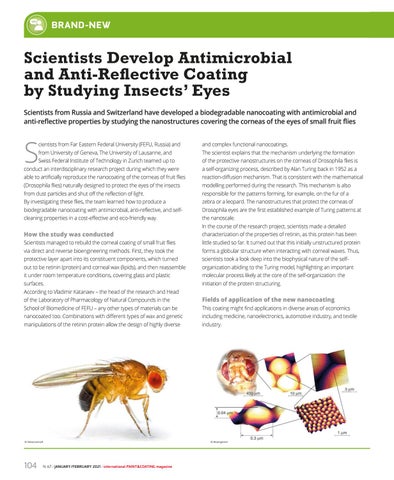BRAND-NEW
Scientists Develop Antimicrobial and Anti-Reflective Coating by Studying Insects’ Eyes Scientists from Russia and Switzerland have developed a biodegradable nanocoating with antimicrobial and anti-reflective properties by studying the nanostructures covering the corneas of the eyes of small fruit flies
S
cientists from Far Eastern Federal University (FEFU, Russia) and
and complex functional nanocoatings.
from University of Geneva, The University of Lausanne, and
The scientist explains that the mechanism underlying the formation
Swiss Federal Institute of Technology in Zurich teamed up to
of the protective nanostructures on the corneas of Drosophila flies is
conduct an interdisciplinary research project during which they were
a self-organizing process, described by Alan Turing back in 1952 as a
able to artificially reproduce the nanocoating of the corneas of fruit flies
reaction-diffusion mechanism. That is consistent with the mathematical
(Drosophila flies) naturally designed to protect the eyes of the insects
modelling performed during the research. This mechanism is also
from dust particles and shut off the reflection of light.
responsible for the patterns forming, for example, on the fur of a
By investigating these flies, the team learned how to produce a
zebra or a leopard. The nanostructures that protect the corneas of
biodegradable nanocoating with antimicrobial, anti-reflective, and self-
Drosophila eyes are the first established example of Turing patterns at
cleaning properties in a cost-effective and eco-friendly way.
the nanoscale.
How the study was conducted
In the course of the research project, scientists made a detailed characterization of the properties of retinin, as this protein has been
Scientists managed to rebuild the corneal coating of small fruit flies
little studied so far. It turned out that this initially unstructured protein
via direct and reverse bioengineering methods. First, they took the
forms a globular structure when interacting with corneal waxes. Thus,
protective layer apart into its constituent components, which turned
scientists took a look deep into the biophysical nature of the self-
out to be retinin (protein) and corneal wax (lipids), and then reassemble
organization abiding to the Turing model, highlighting an important
it under room temperature conditions, covering glass and plastic
molecular process likely at the core of the self-organization: the
surfaces.
initiation of the protein structuring.
According to Vladimir Katanaev – the head of the research and Head of the Laboratory of Pharmacology of Natural Compounds in the
Fields of application of the new nanocoating
School of Biomedicine of FEFU – any other types of materials can be
This coating might find applications in diverse areas of economics
nanocoated too. Combinations with different types of wax and genetic
including medicine, nanoelectronics, automotive industry, and textile
manipulations of the retinin protein allow the design of highly diverse
industry.
© Wissenschaft
104
N. 67 - JANUARY/FEBRUARY 2021 - international PAINT&COATING magazine
© Bioengineer
